Shoyu ramen, miso ramen, tantanmen, all these ramen dishes have their own charms. Yet none feels as clean and soulful as a perfect bowl of shio ramen.
My recipe builds transparent, umami-rich broth using only natural ingredients and precise temperature control. No shortcuts, no bouillon cubes, no artificial flavor enhancers.
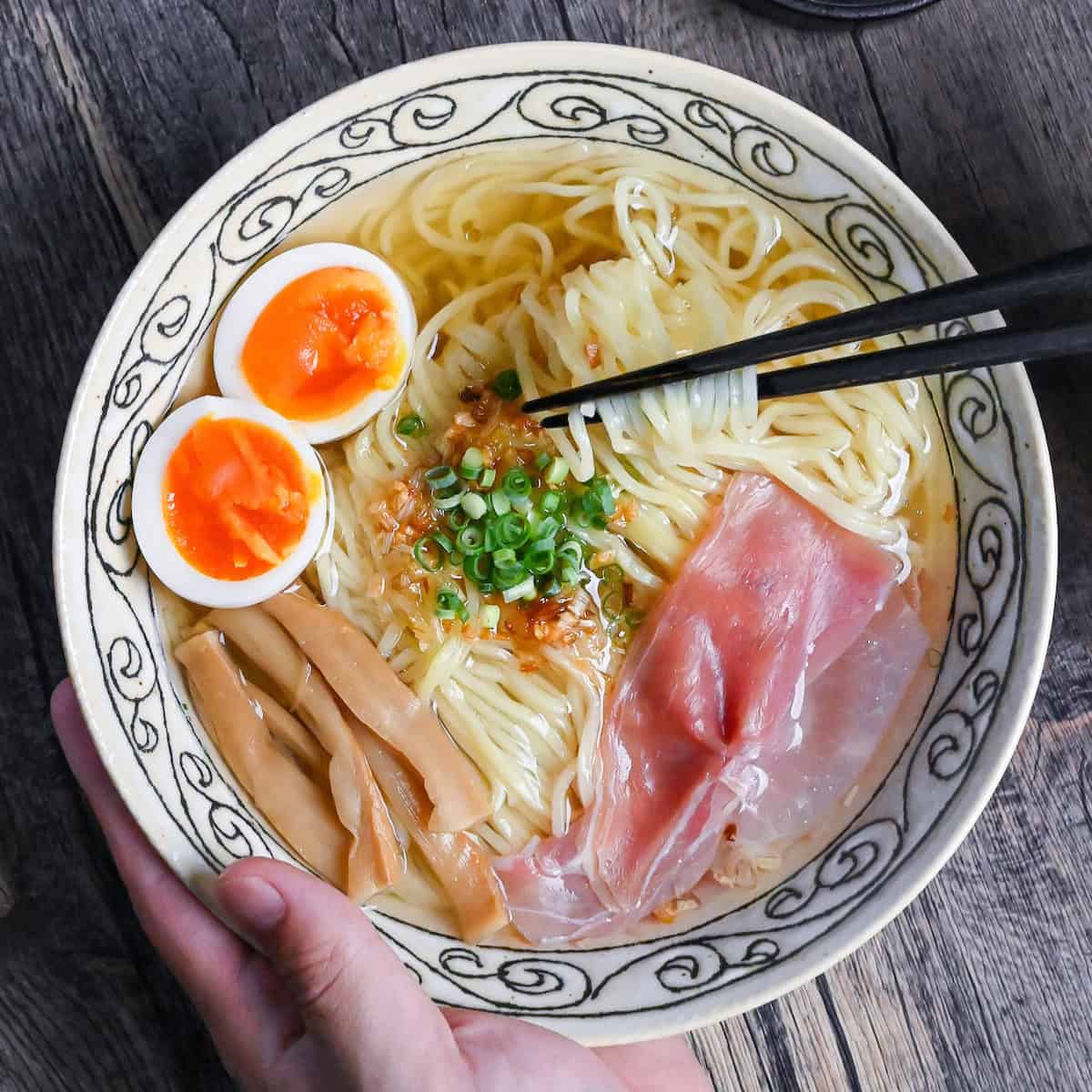
Shio Ramen
Recipe Snapshot
- What is it? Crystal-clear shio ramen with four-layer umami.
- Flavor profile: Umami-rich, Light, Delicate
- Why you’ll love this recipe: This recipe explains the why behind every step from temperature control to ingredient timing, so you’ll never make cloudy broth again.
- Must-haves: Kombu, Dried scallops or clam juice, Bonito flakes
- Skill Level: Medium
- Suitable for Meal Prep? Yes!
Summarize & Save this content on:
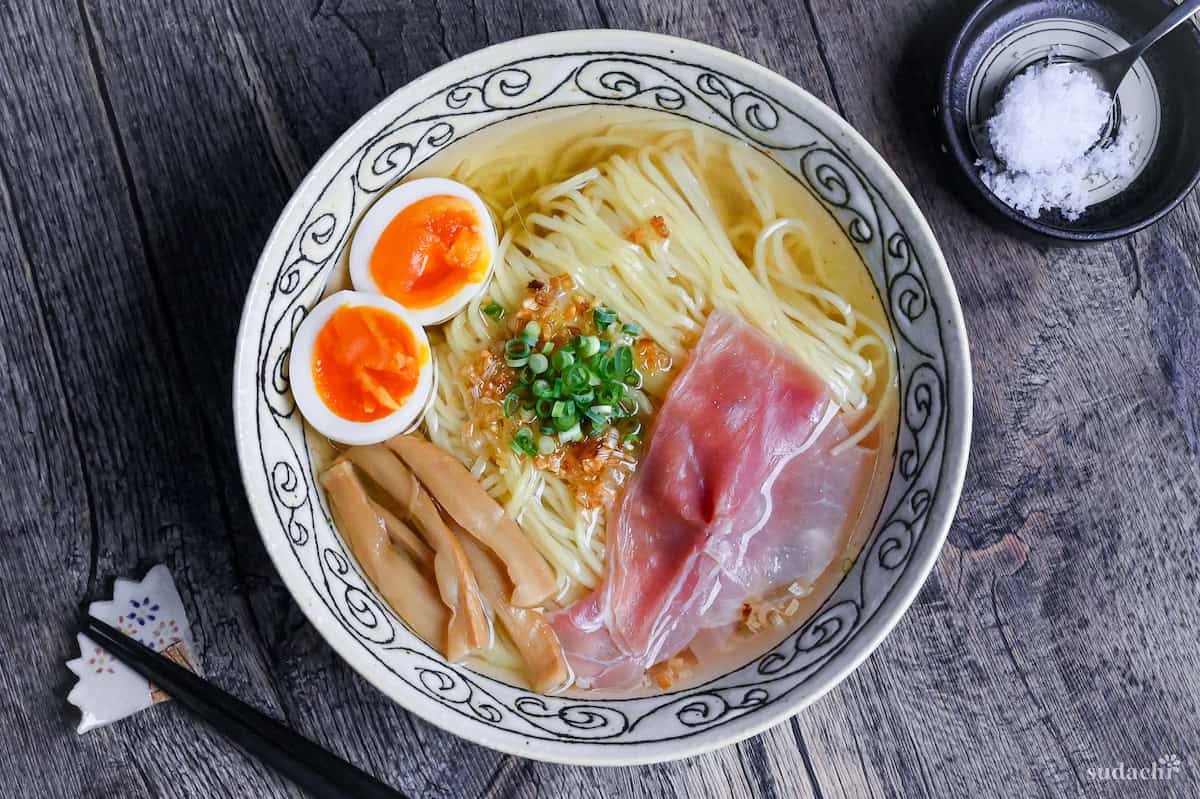
What is Shio Ramen?
Shio ramen is the most delicate style of ramen, built on a clear broth seasoned primarily with salt. Unlike the rich depth of tonkotsu ramen or the bolder taiwan ramen, shio’s elegance lies in restraint. Its soup is meant to be almost as clear as Japanese clear soup, yet layered with profound umami.
Every detail matters, from the tare’s salinity to the aroma oil’s balance, because there’s no heavy flavoring to hide behind.
Because of its clean finish, shio ramen pairs beautifully with side dishes like gyoza, where the crispy dumplings add contrast to the broth’s subtle clarity.

How I Built My Shio Ramen Broth
My broth starts with a blend philosophy: chicken × kombu × fish × shellfish. Each brings its own key amino acid. Glutamate from kombu, inosinate from chicken & fish, succinate from shellfish.
Put these umami factors together, and suddenly 1 + 1 doesn’t equal 2. It equals 5 or even 7. That’s the secret to why this broth feels so much bigger than its parts.
This is why a well-made shio ramen can feel both light and deeply satisfying. It’s structured to highlight purity, not heaviness.
Shio Ramen Ingredients
What You’ll Need for Shiso Ramen Broth
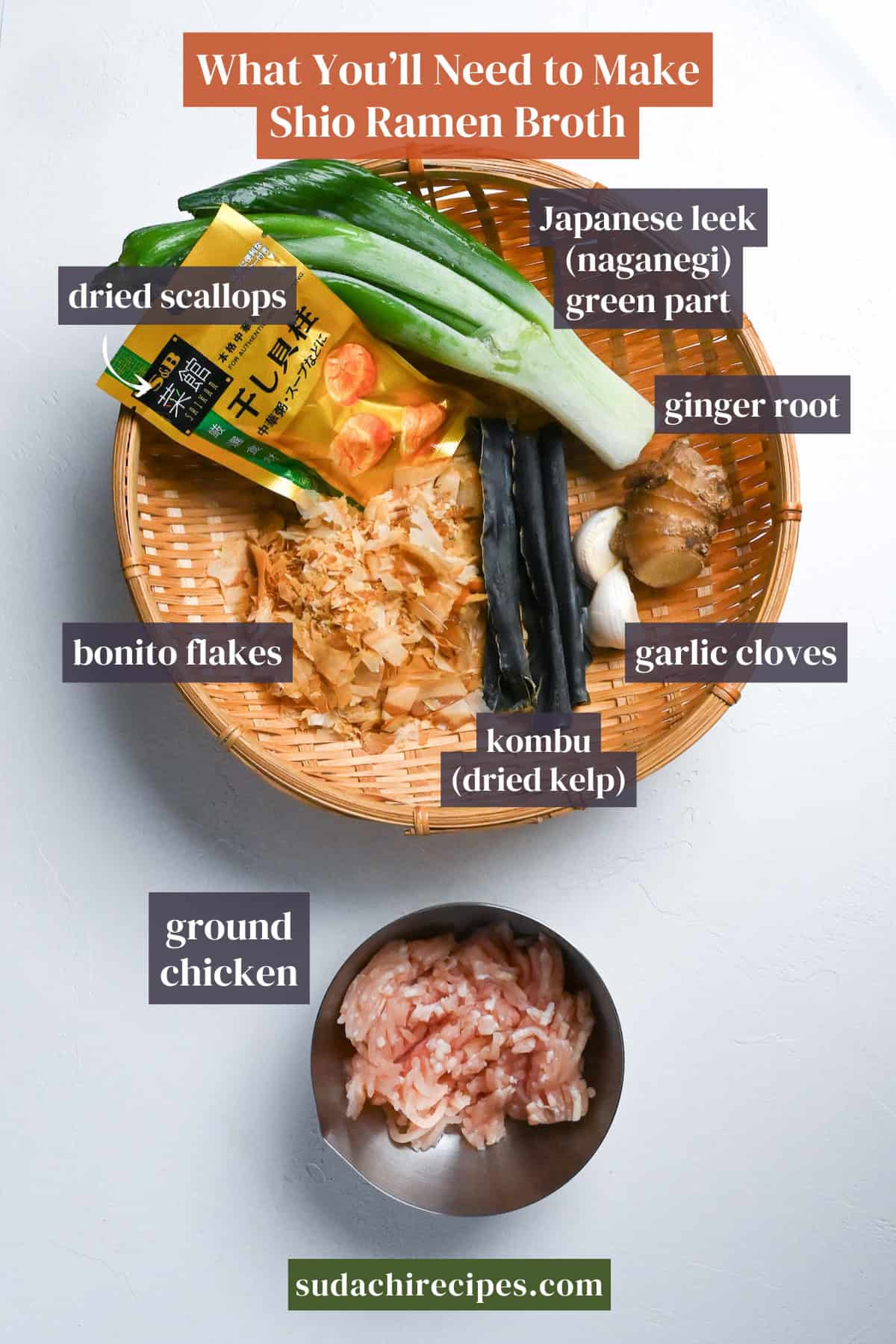
- Ground chicken: ground meat exposes more surface area, so you pull gentle chicken savoriness without clouding. Swap 1:1 with ground turkey, or use wings/drumsticks for extra collagen and body. Just keep to a bare simmer and skim for a crystal-clear, softly chicken-aromatic finish.
- Japanese leek (green part): It can be stocked at Asian groceries, and sometimes labelled as “Tokyo negi”. If you can’t find it, use regular leek or regular onion.
- Dried scallops (conpoy): Look for them in the dried-seafood aisle at Asian markets. No dried scallops? Use the liquid from canned clams/scallops or a splash of bottled clam juice to infuse succinate acid.
What You’ll Need for Shiso Ramen
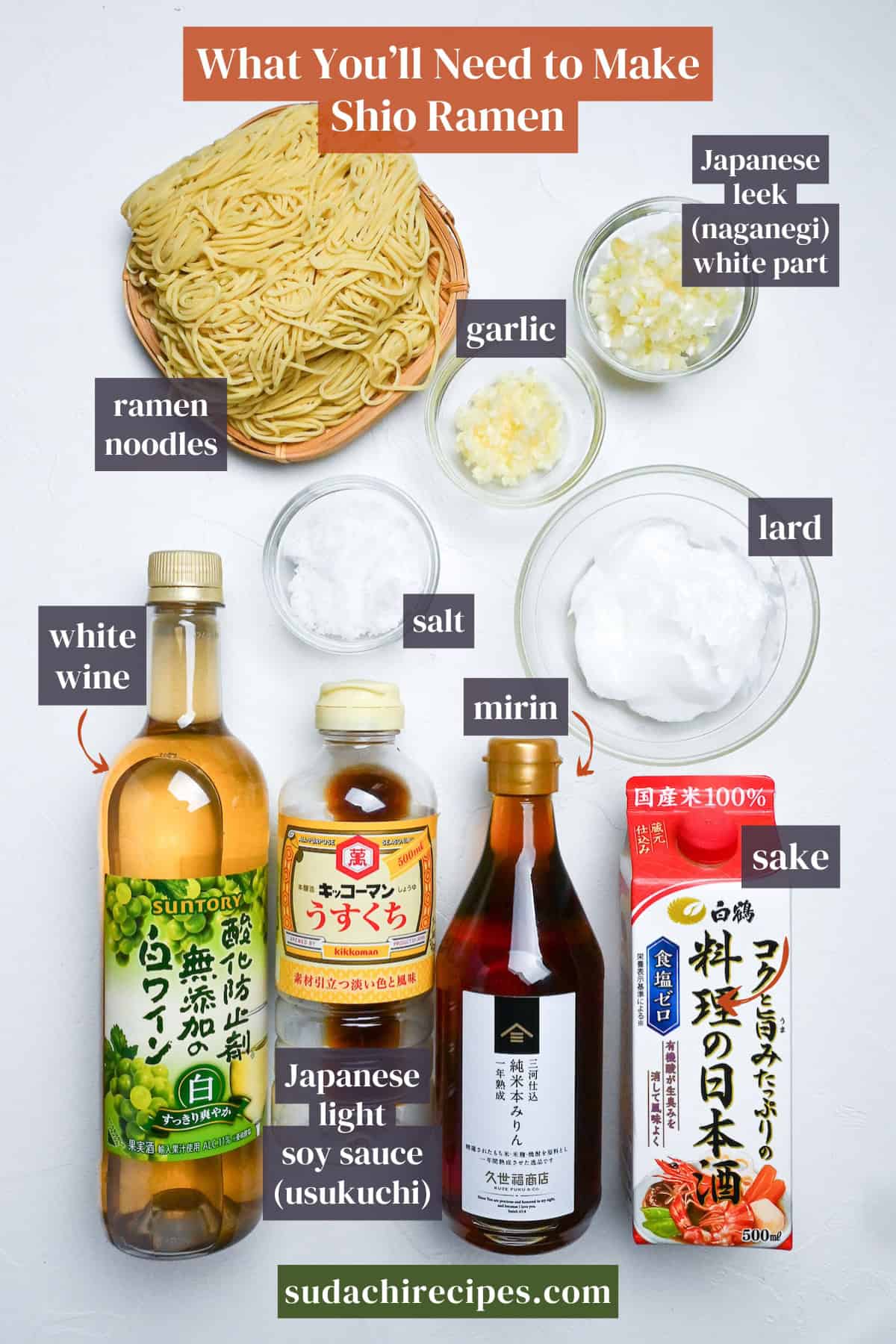
- Ramen noodles: For shio ramen, aim for thin to medium-thin, slightly lower-hydration noodles with a springy bite. Check out my homemade ramen noodles recipe if you want a fun weekend challenge!
- Japanese light soy sauce (usukuchi): To keep your broth pale, I recommend usukuchi (light-color shoyu) or shiro shoyu (white soy sauce). Check out online shops if you’re interested in getting one. If all you have is regular shoyu, that’s totally fine. It will be delicious but will tint the broth and add rounder, darker soy notes.
Substitution List
- Ground chicken: Ground turkey, chicken wings/drumsticks.
- Japanese leek (green part): Regular leek, onion, shallot green.
- Japanese leek (white part): Yellow or white onion.
- Dried scallops (conpoy): Liquid from canned clams/scallops, bottled clam juice.
- Lard: Jarred chicken fat, duck fat.
- Sake: Dry sherry, white white wine.
- Fresh ramen noodles: Dried ramen noodles (Japanese brands recommended).
Have trouble finding Japanese ingredients? Check out my ultimate guide to Japanese ingredient substitutes!
How to Make My Shio Ramen
If you prefer to watch the process in action, check out my YouTube video of this shio ramen recipe!
i. Add water to a pot, then add kombu and a few dried scallop (conpoy) and soak 30 minutes off the heat. Keep the pot cool and covered during the soak to avoid clouding or sliminess.
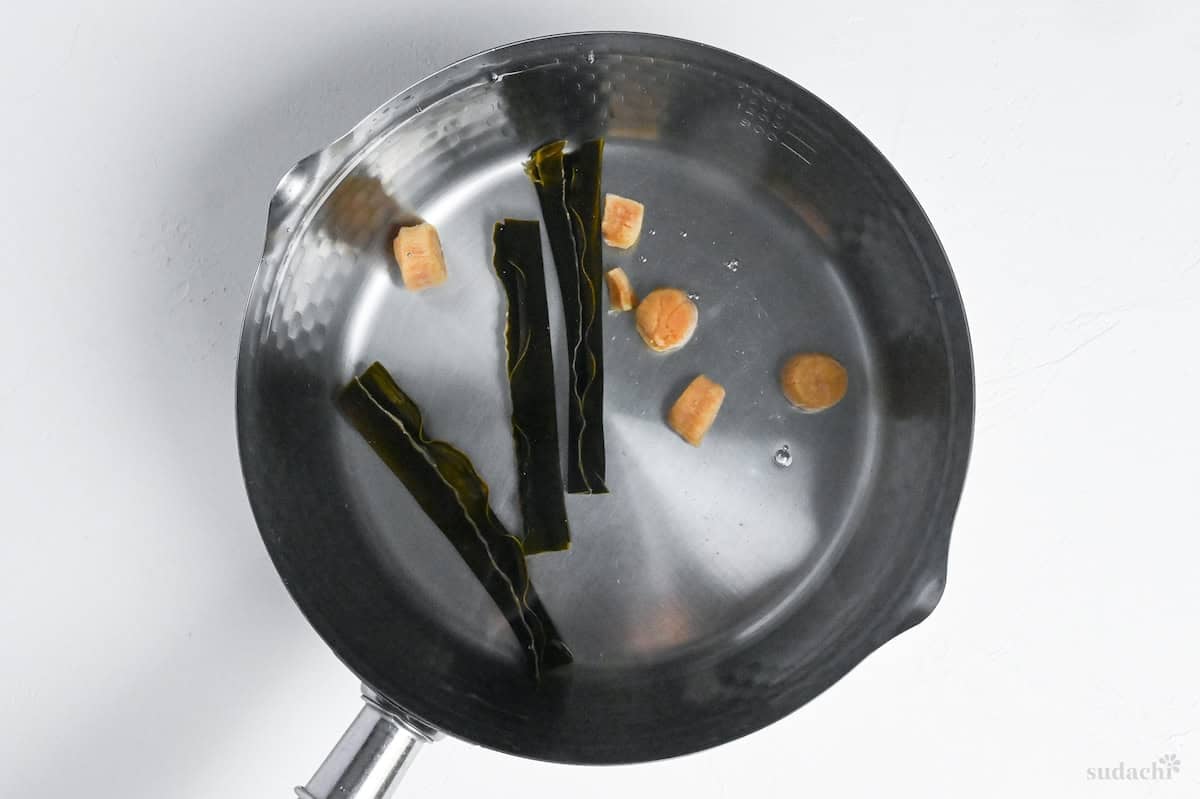
Soft water extracts glutamates from kombu more cleanly than hard water, giving you a delicate, clear base to build on.
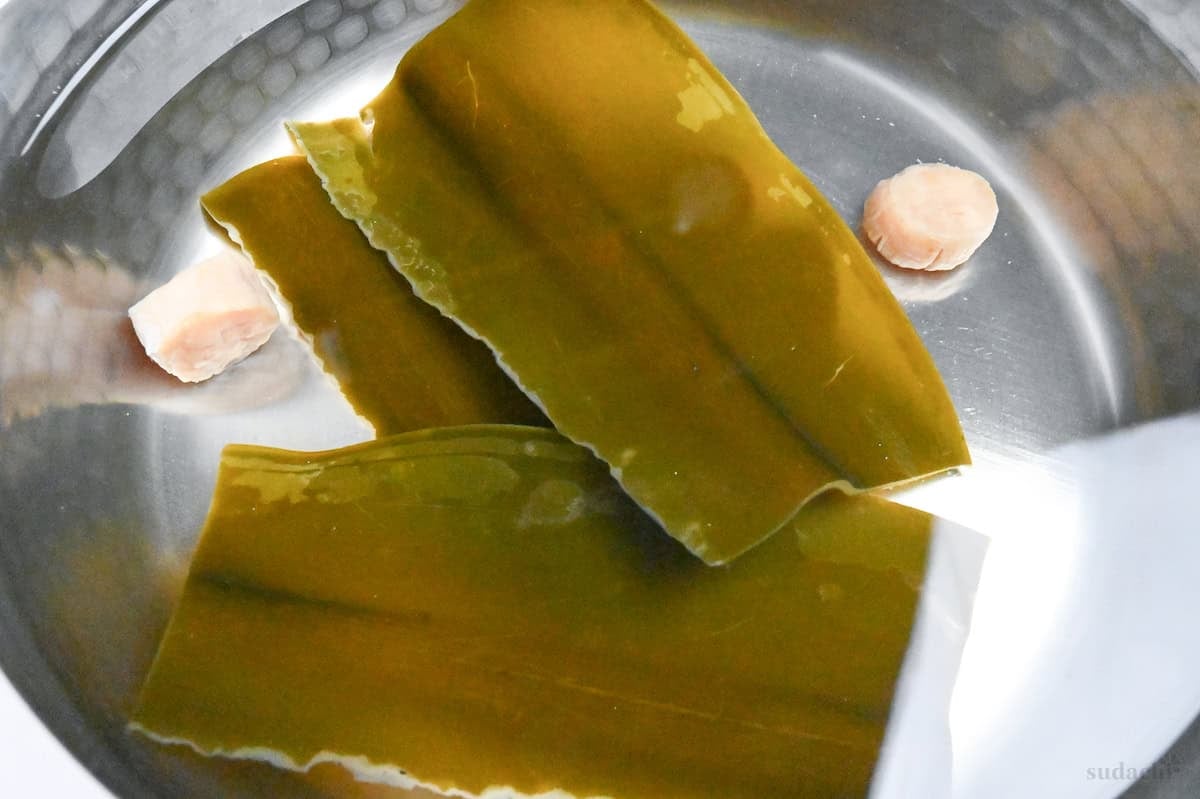
If dried scallops are unavailable, add clam juice or the packing liquid from canned clams/scallops later when you blend the broth with tare.
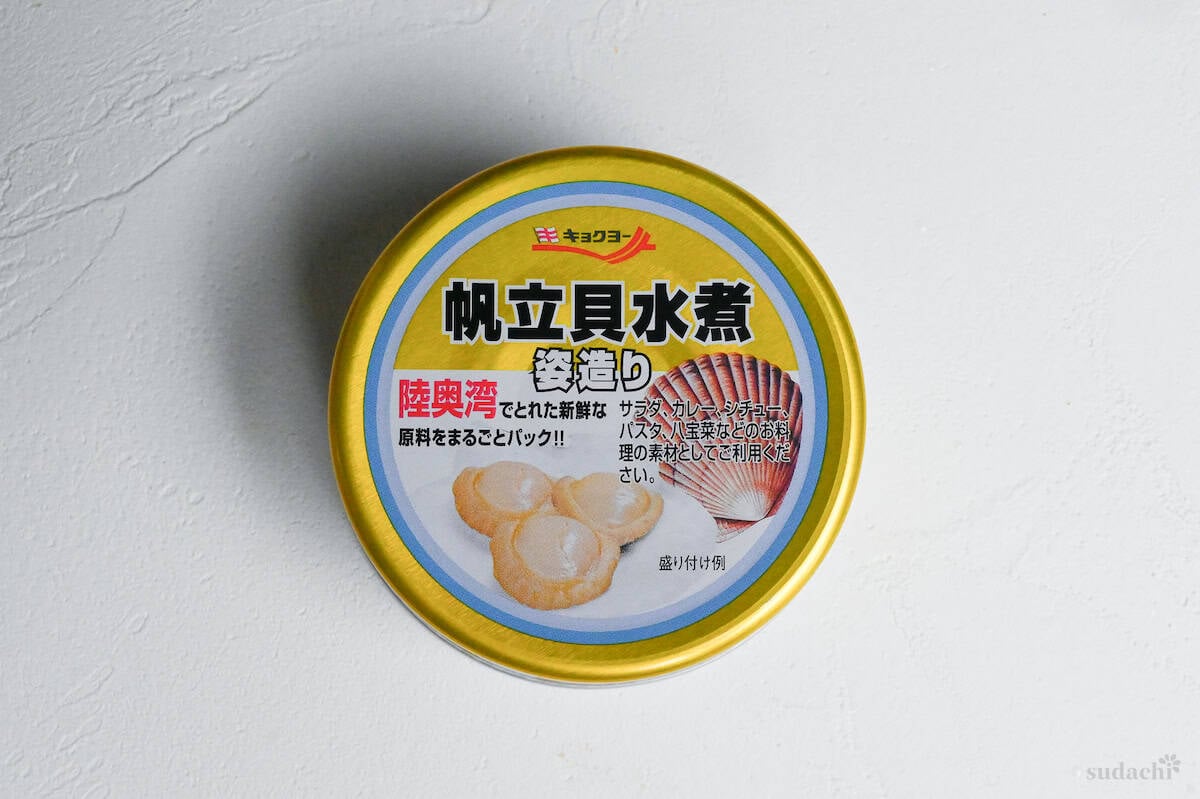
ii. While you wait, I recommend prepare your aromatics as follow:
- Ginger root: rough chunks
- Garlic: remove skin and gently crack with the flat side of your knife.
- Japanese leek: cut off the green part.
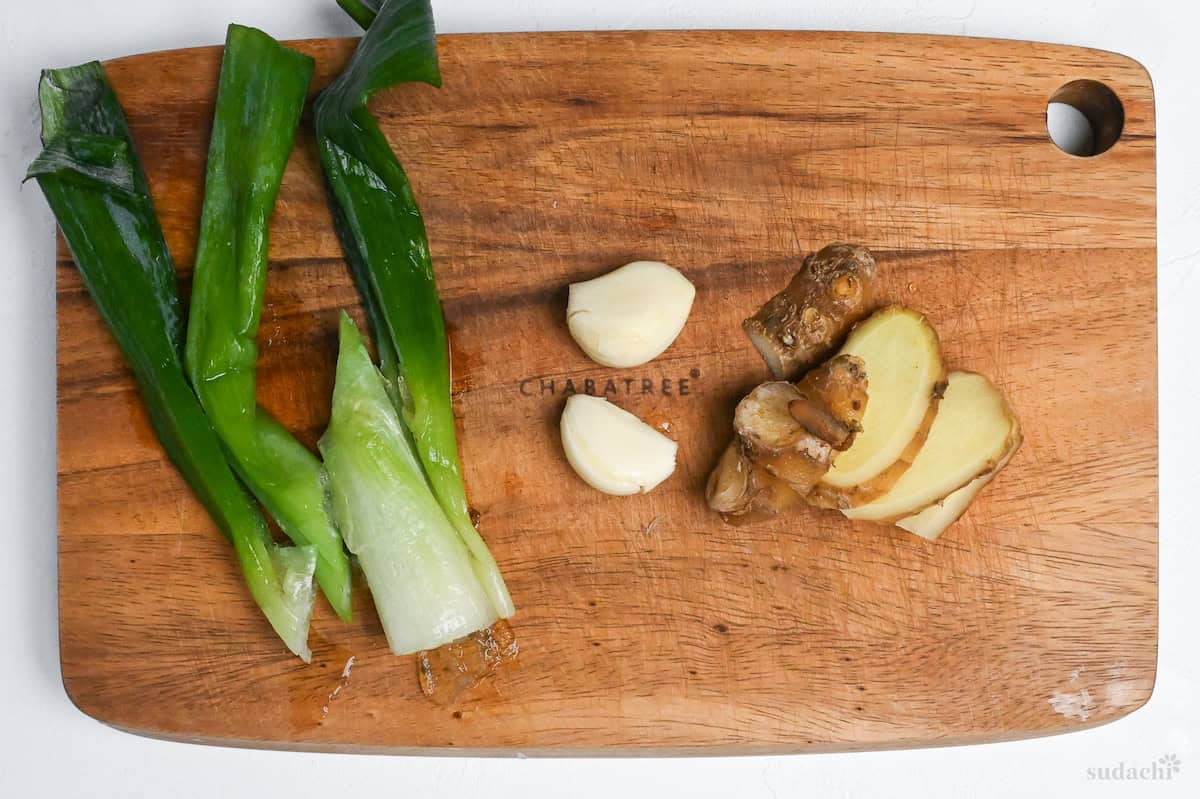
iii. After 30 minutes, turn the heat on medium and add ground chicken (or wings/carcasses/drumsticks) to the pot and gently break it apart with chopsticks.
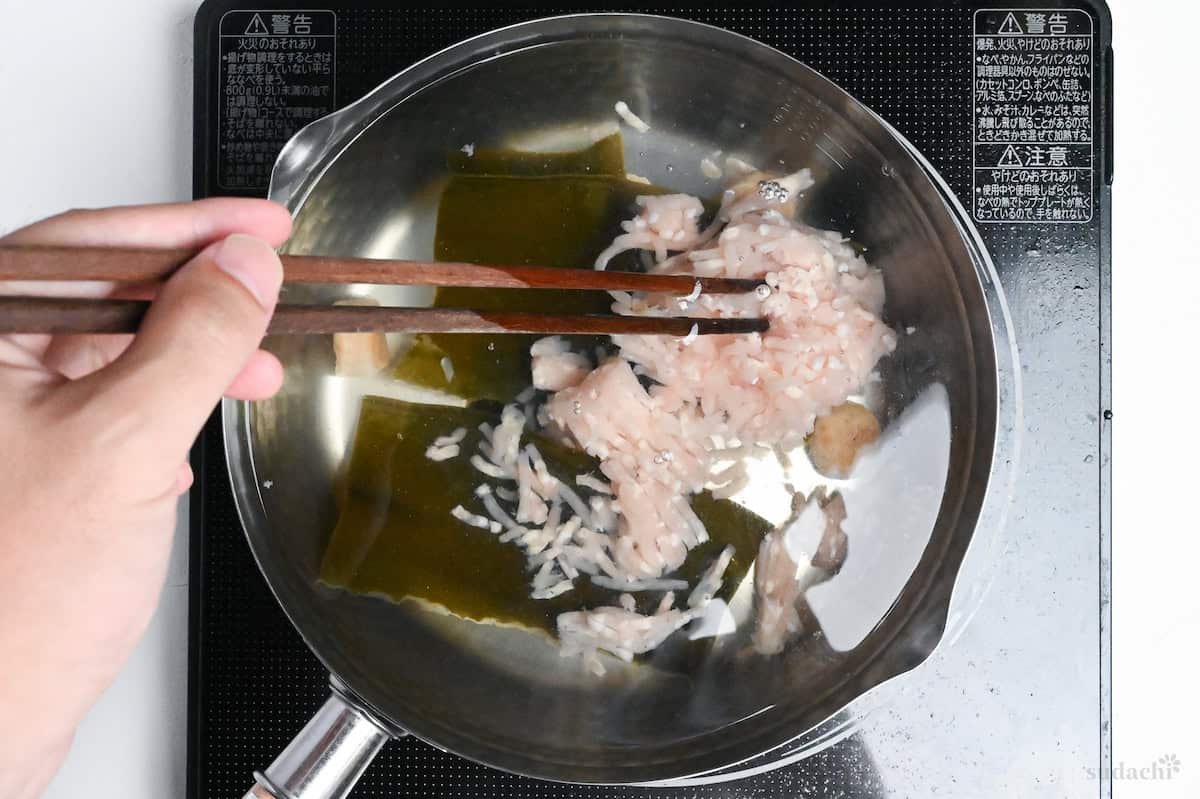
iv. Remove the kombu and scallops just before the water reaches a simmer to prevent sliminess or bitterness, then keep the liquid at a gentle simmer-about 82-90℃ (180-194°F).
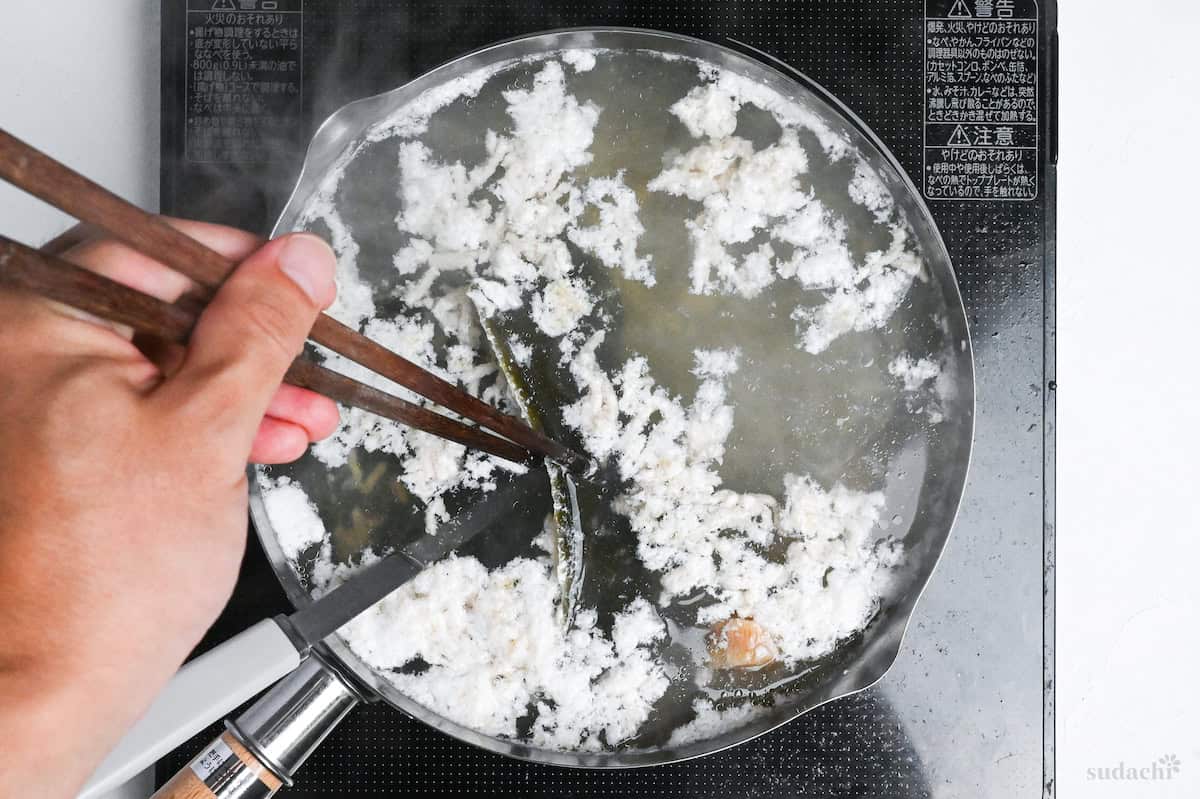
The used kombu still has life in it by making kombu onigiri (rice balls)!
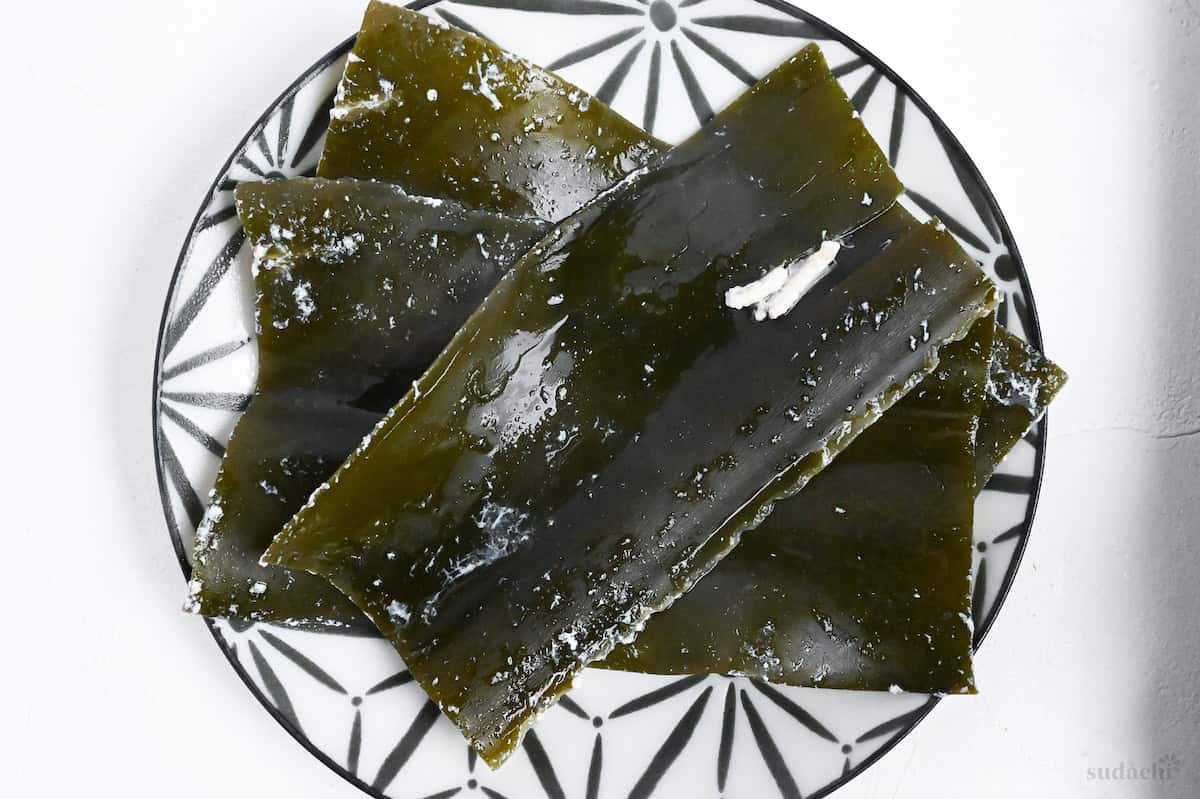
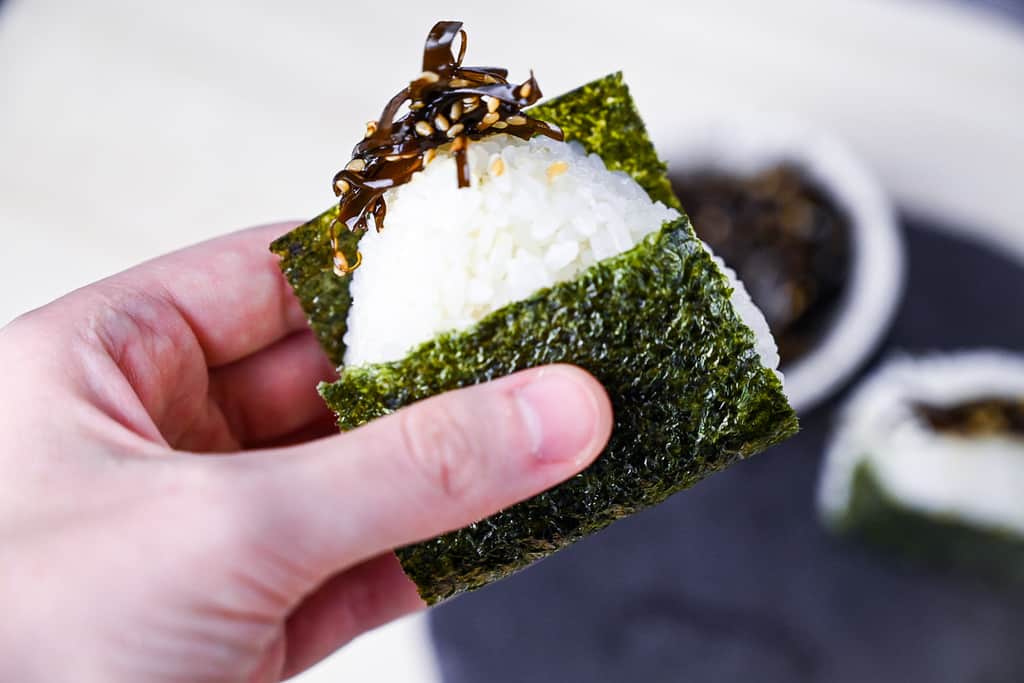
v. Skim foam as it rises and avoid stirring/agitation, which emulsifies fat and clouds the stock.
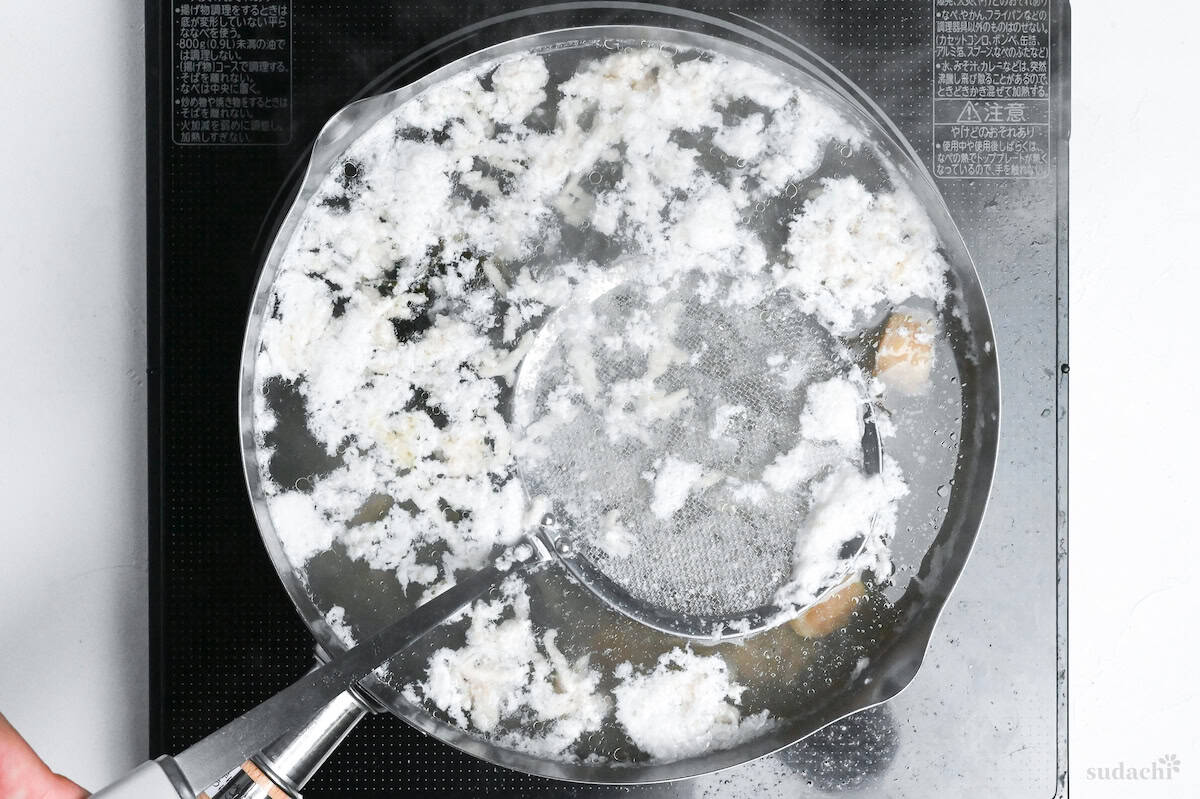
vi: Lower to maintain that gentle simmer and add sliced ginger, garlic cloves, and Japanese negi, and simmer 30 minutes without a lid.
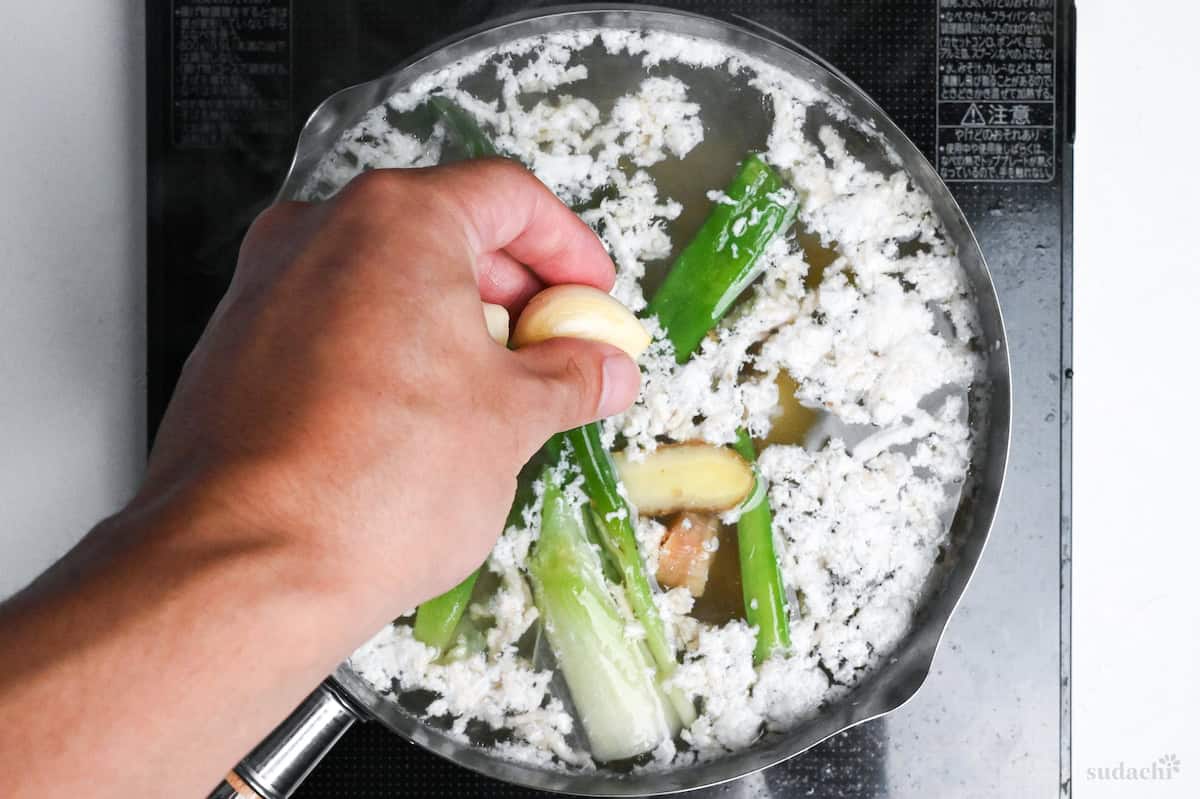
vii. You’re looking for a light, savory aroma with a few lazy bubbles (frémissement/bare simmer). Agitation or a rolling boil will send scum and fat back into suspension. Keep skimming so the surface stays clear.
i. In a small pan, combine lard (or chicken schmaltz/duck fat), finely diced negi (white part), and garlic cloves; warm over low heat until the alliums turn pale blond and fragrant.
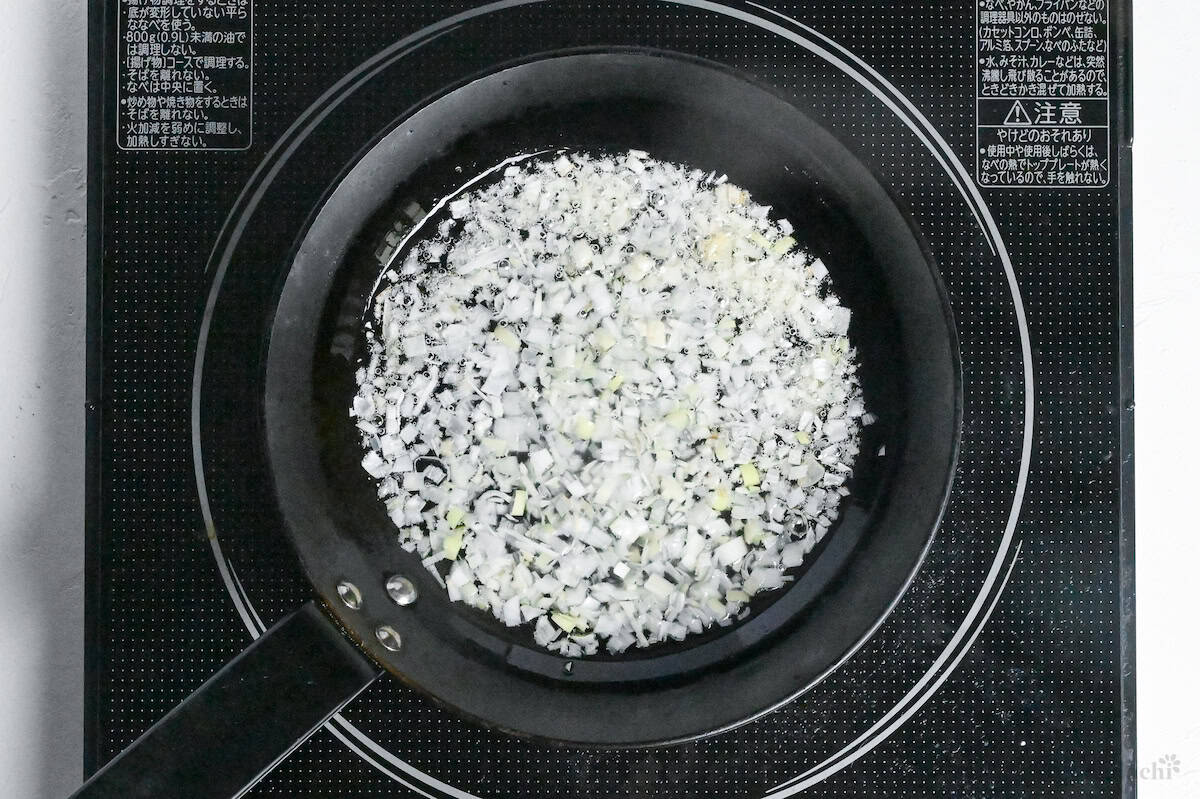
Then remove from heat before browning. Strain if you want a pristine oil, or leave the bits in for rustic texture.
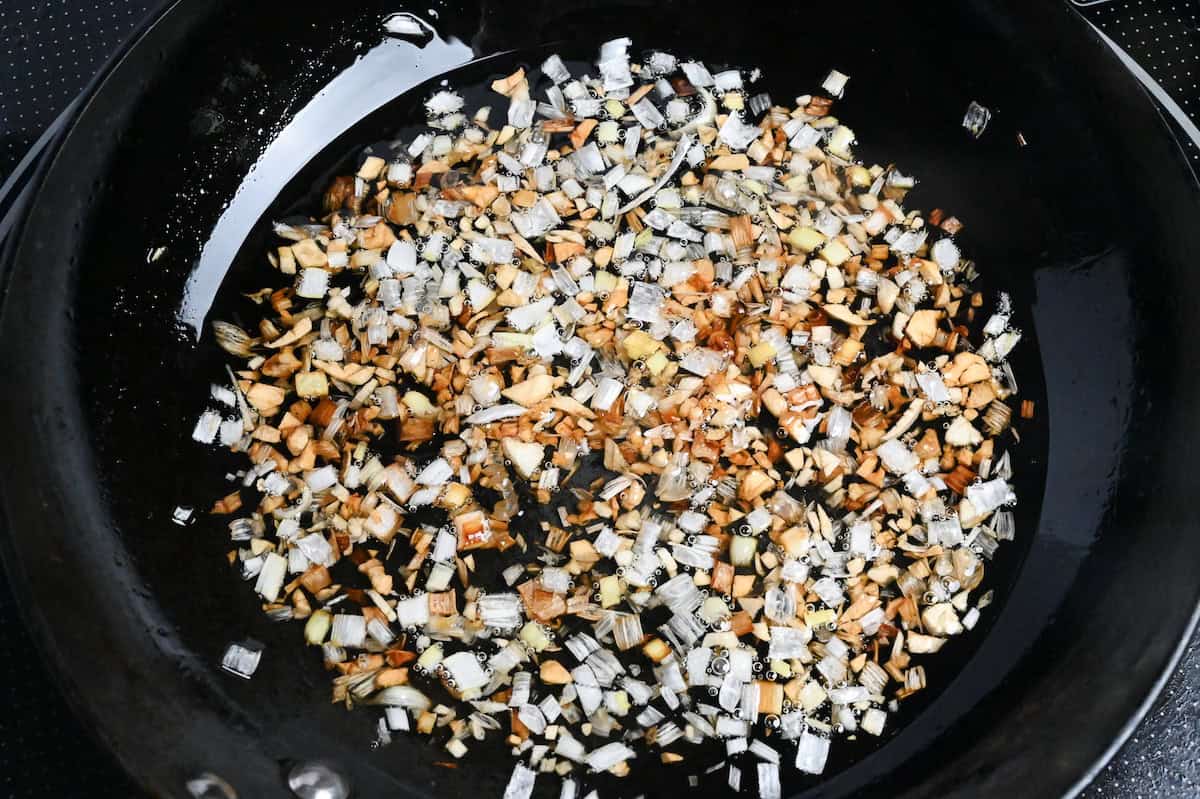
No lard, chicken/duck fat? Use neutral cooking oil and finish with a few drops of toasted sesame oil. No Japanese leek? Western leeks or even mild onions will give you similar results.
i. Do this step simultaneously with step 2. In a small saucepan, add sake, dry white wine, mirin, and fine sea salt. Heat over medium while stirring until the salt dissolves into the mixture.
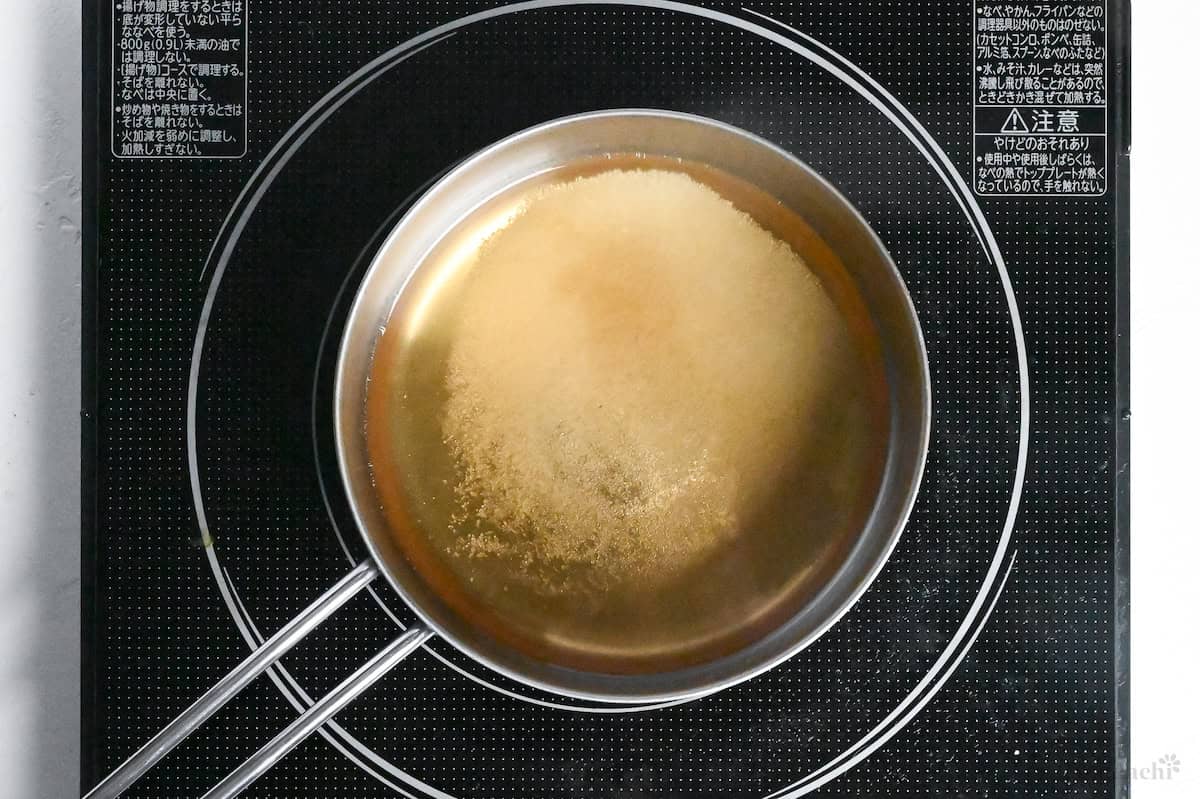
ii. Let it bubble for 2 minutes or until the you can no longer smell the alcohol, then turn off heat and stir in usukuchi (light-colored) soy sauce. Set the oil and tare aside for later.
Use high-quality sea salt or a blend of sea and rock salt for the best mineral balance. If you can find white soy sauce (shiro shoyu), it’ll keep your broth even clearer while adding that essential fermented depth.
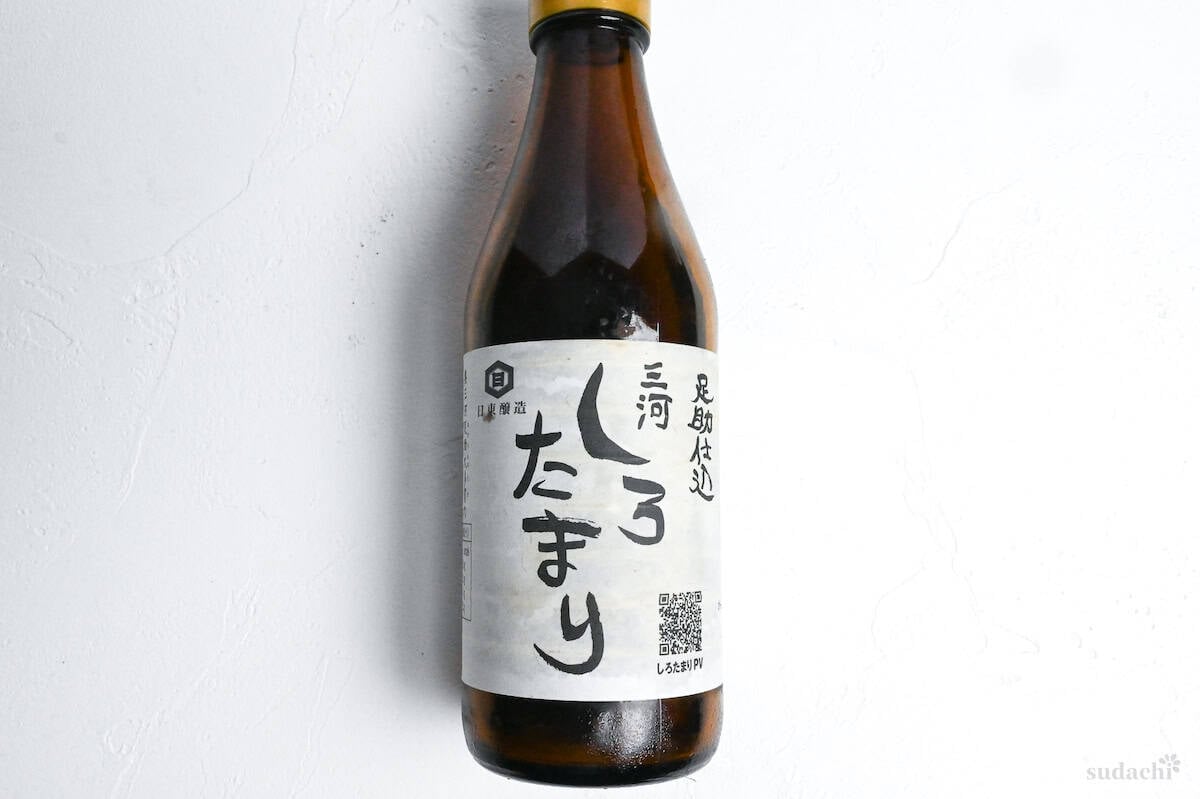
i. After 30 minutes of simmering, lift out the chicken and aromatics using a mesh spoon.
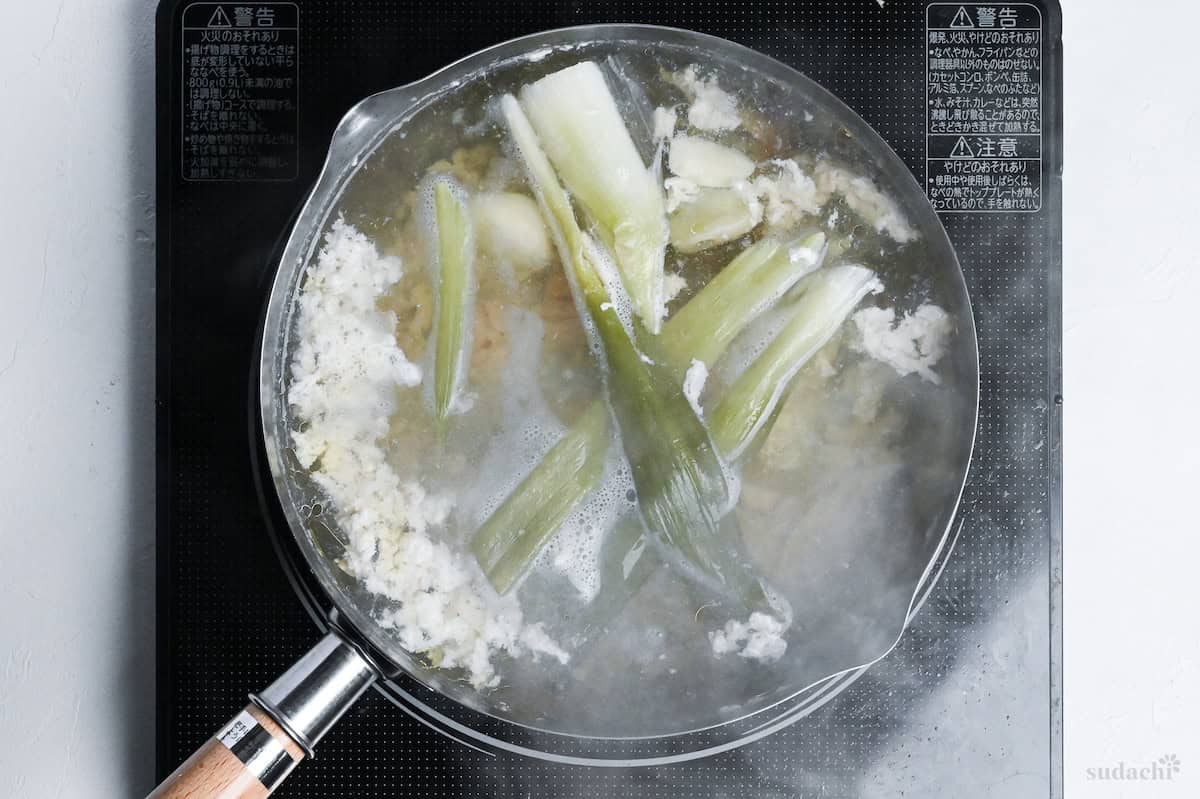
Don’t toss the cooked ground chicken! Frying it with a few simple condiments makes excellent filling for chicken onigiri.
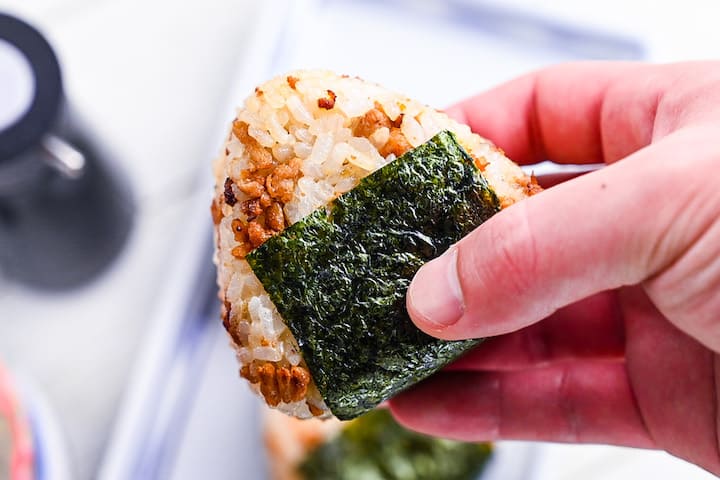
ii. Bring the broth just to the edge of a simmer, turn off the heat, add a handful of katsuobushi, and steep 2 minutes before lifting it out. The broth should smell clean and smoky-sweet.
Only a few minutes of katsuobushi infusion to capture fragrance/inosinate without sour notes. Steeping for too long can turn your broth can turn astringent.
i. Line a fine-mesh strainer with two layers of paper towel or a clean cloth. For restaurant-level clarity, some chefs use cheesecloth or even coffee filters.
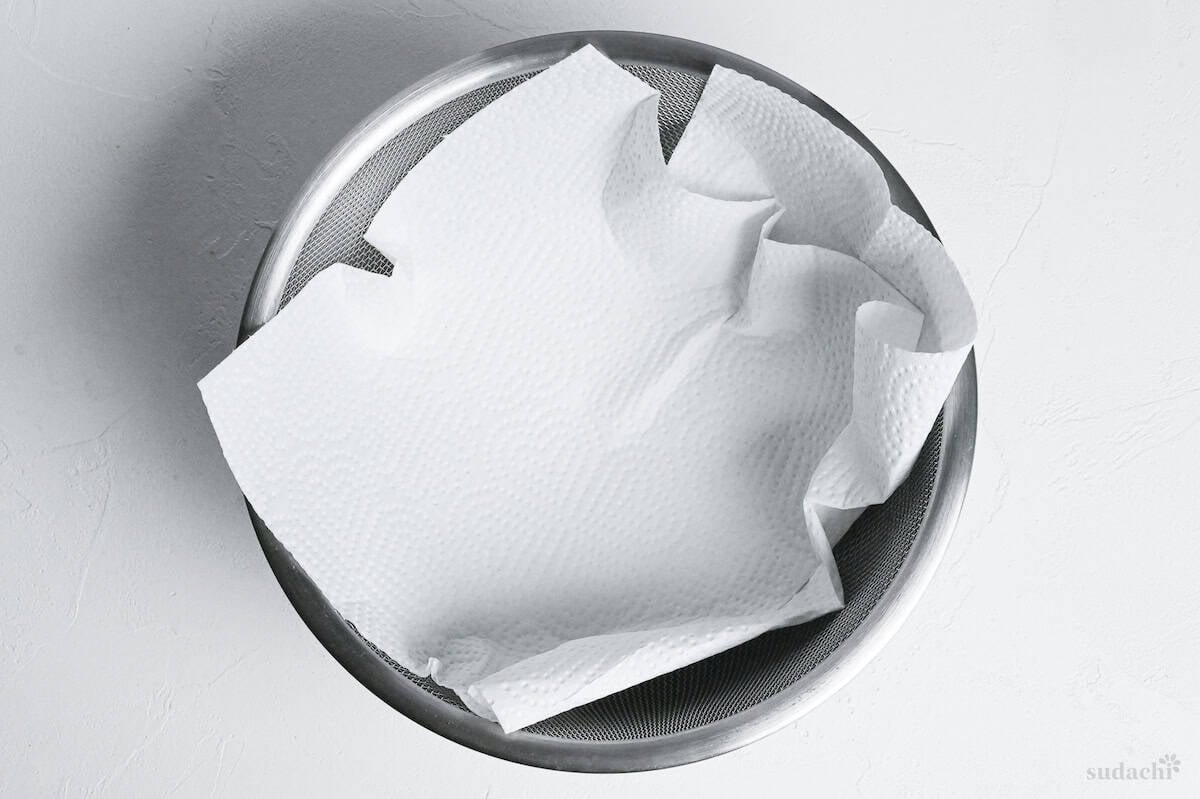
ii. And strain without pressing.
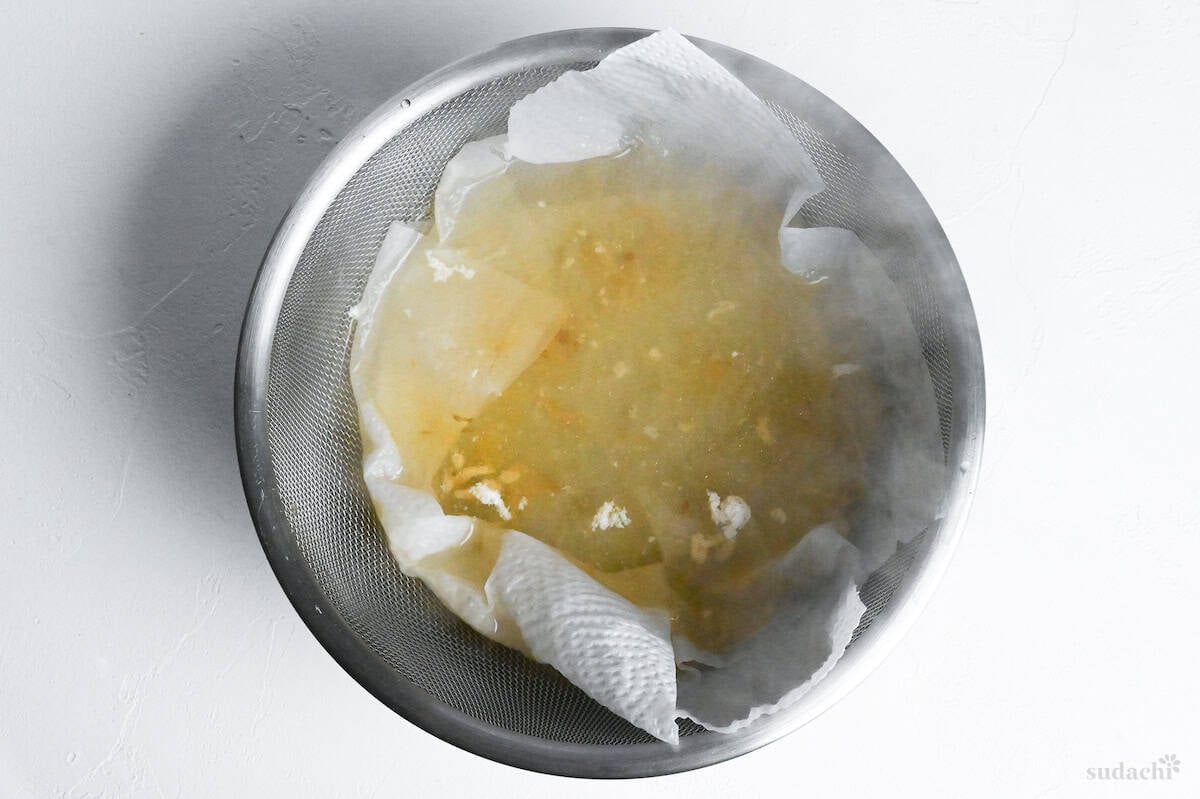
iii. Measure the broth, and top up with hot water to 1,400 ml to lock in a consistent tare-to-broth ratio for even salinity from bowl to bowl.
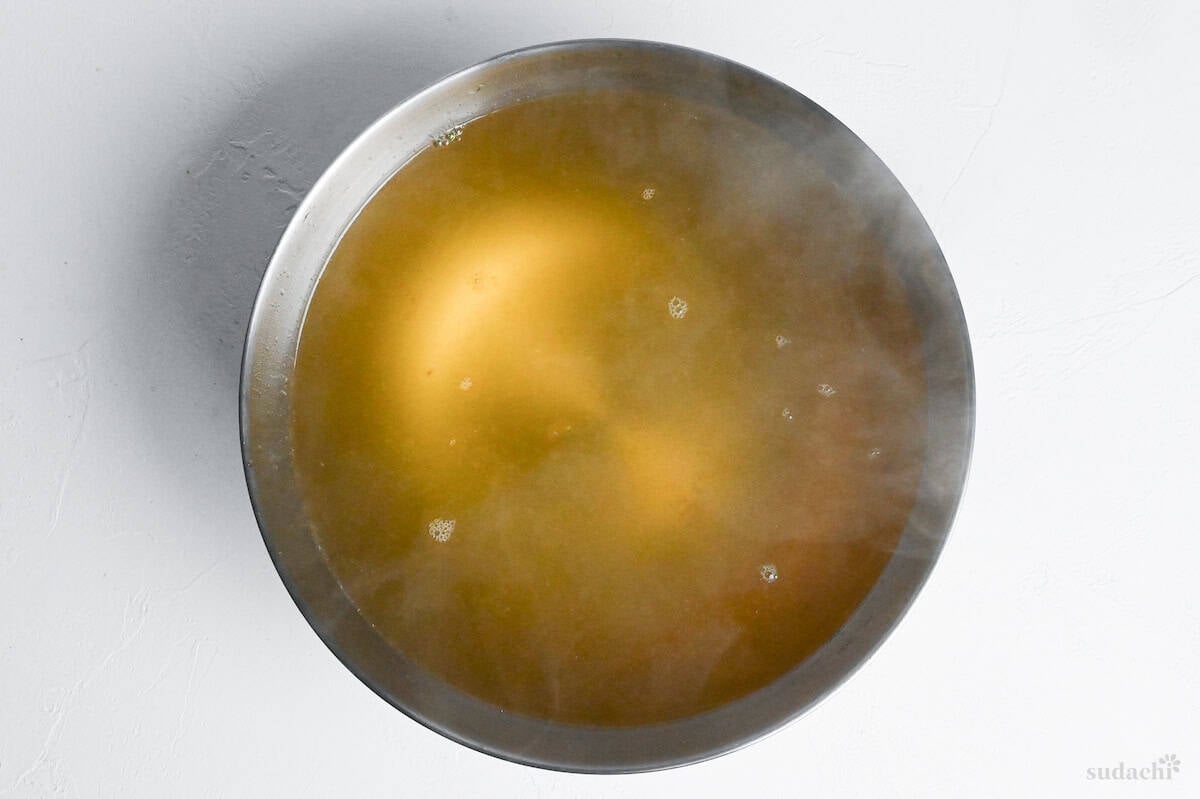
i. Cook your ramen noodles according to package directions, aiming for slightly firmer than usual.

ii. Drain thoroughly so starchy cooking water doesn’t cloud the bowl. Shio ramen shines with thin to medium-thin, lower-hydration noodles for a delicate, snappy bite.
i. For home cooking, combine your whole tare with the reheated dashi first, then divide between bowls. This ensures even seasoning across servings. Much easier than trying to balance each bowl individually.
ii. Add your cooked noodles.
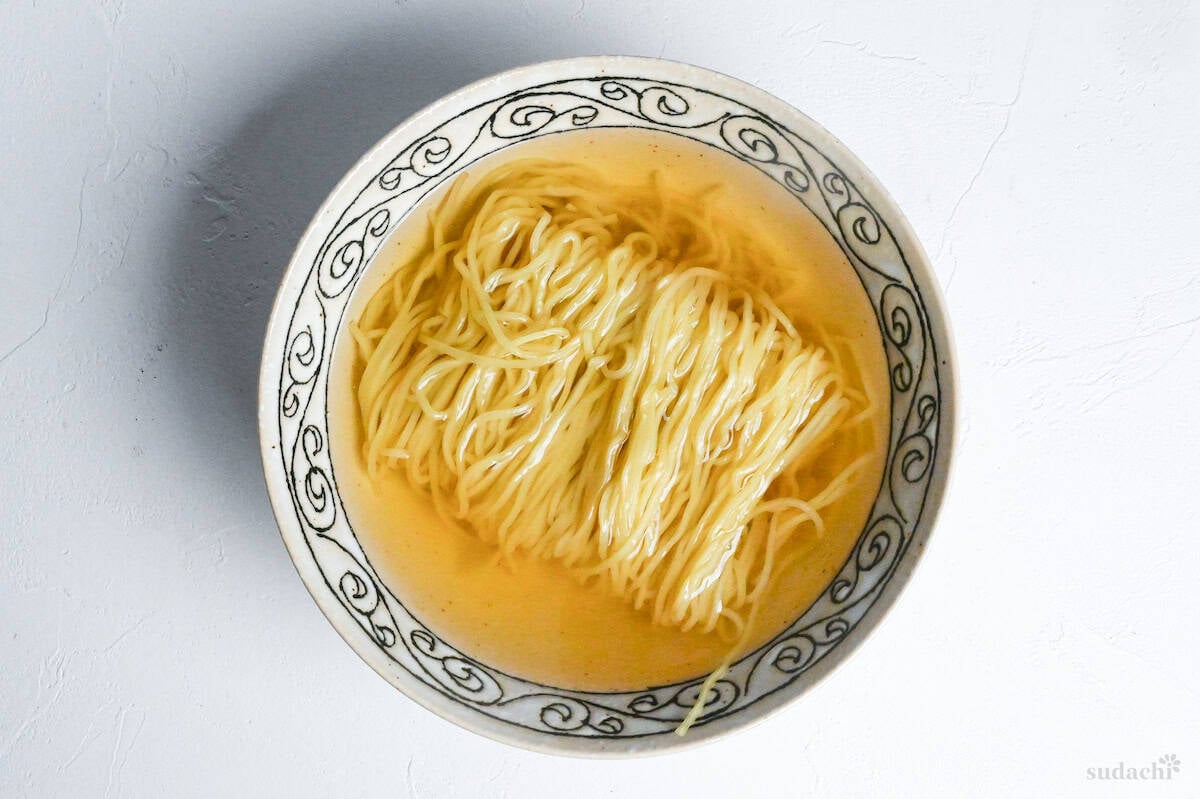
iii. Drizzle with the infused oil.
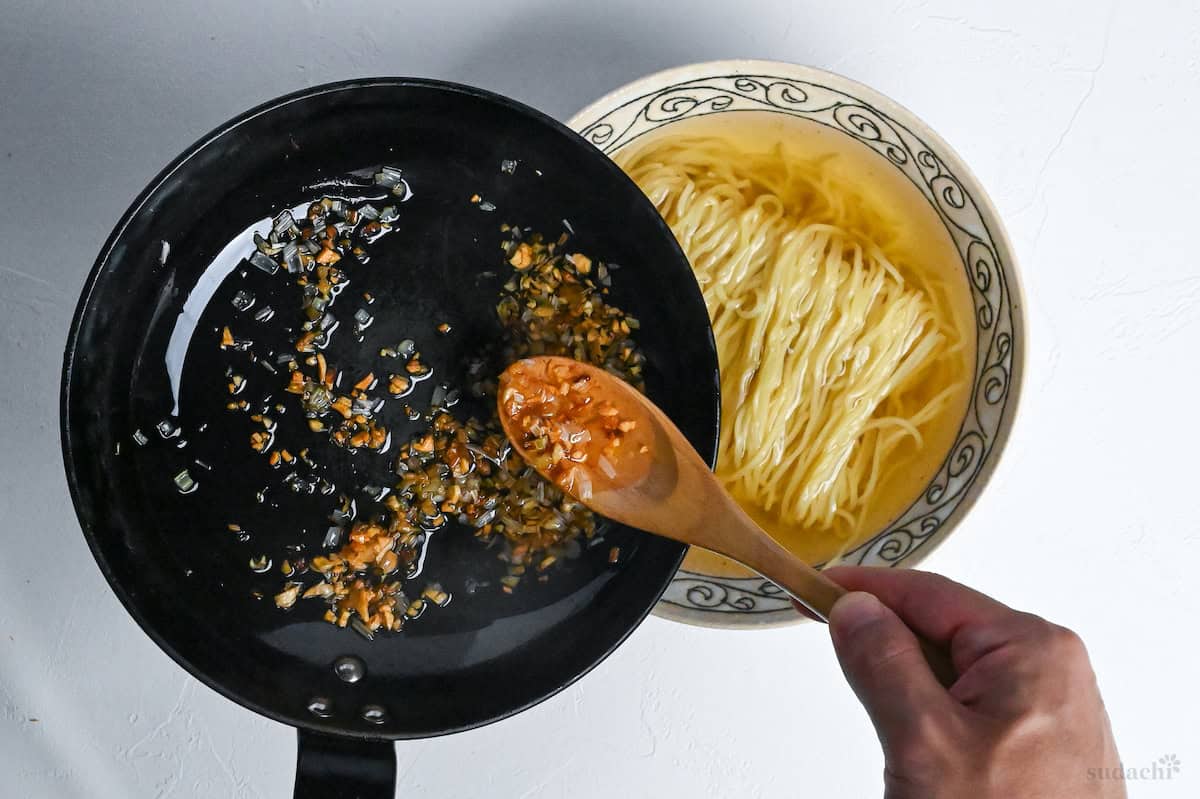
iv. Then arrange your chosen toppings. Serve immediately, shio ramen waits for no one.
Shio ramen demands a fundamentally different approach to toppings than its richer cousins. Where those styles can handle bold, abundant garnishes, shio ramen tends to celebrate minimalism. The goal isn’t to pile on ingredients but to select 2-3 elements that enhance rather than mask your carefully crafted clear broth.
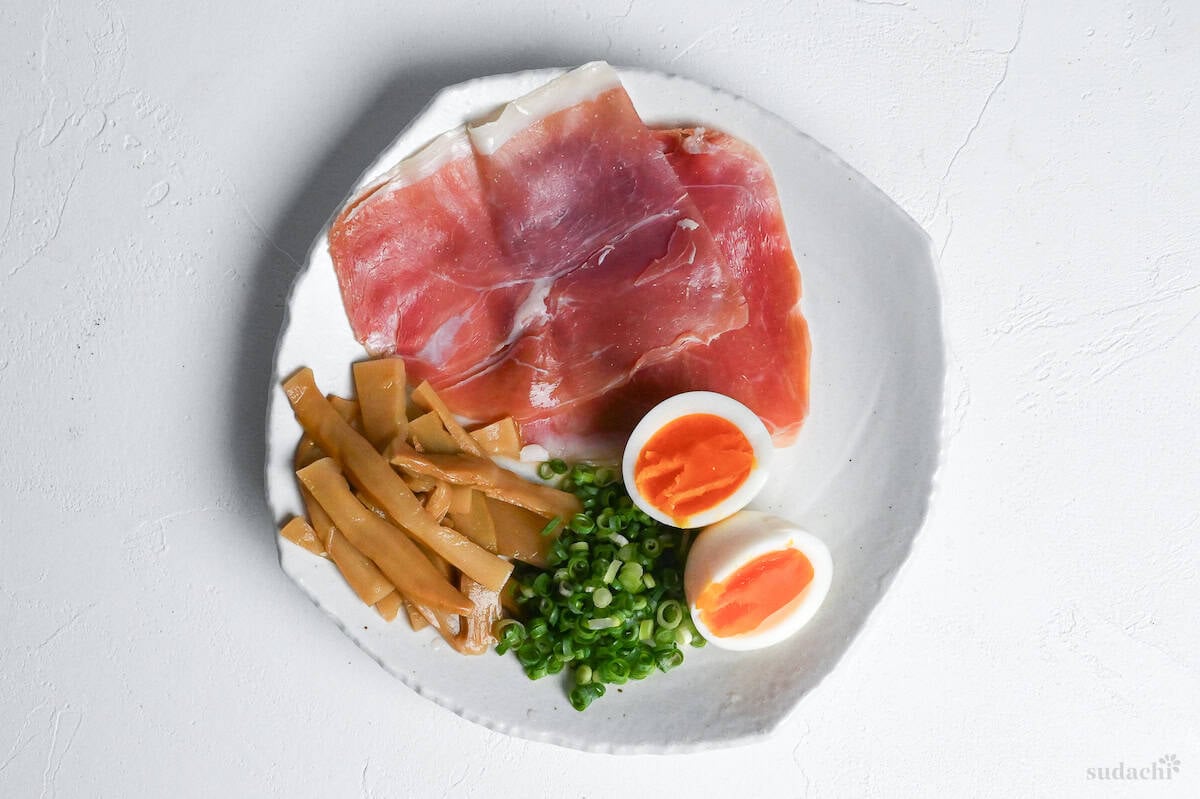
Think of it this way: you’ve just spent an hour creating a delicate symphony of umami. Loading it down with heavy toppings would be like drowning a fine wine with overpowering food. Instead, choose thoughtfully from the options below:
- Modern Shop-Style Alternative: Many contemporary shio ramen shops have moved toward thin-sliced, ham-like proteins. Pastrami, turkey breast, prosciutto cotto, or quality chicken cold cuts work brilliantly. To me, these are all better options than fatty pork chashu for the broth.
- Cooked Chicken: If you’d like to have simple chicken topping, you can use “salad chicken” from my Japanese chicken salad recipe or chicken chashu!
- Traditional Pork Chashu: I personally don’t recommend it. Chashu is a bit too fatty and it can cloud the delicate soup. High-end shio ramen specialty restaurants usually go for leaner chashu, but it’s hard to recreate that at home.
Why do cold cuts work so well? These deli meats hit the perfect balance: minimal fat content, light smoking (though too much smoke overpowers the delicate dashi), and thin slicing that matches current ramen trends while being easier to eat with chopsticks.
- Low fat content: Fatty options throw off the broth’s careful balance.
- Minimal to light smoking: Strong smoke flavors compete with your dashi.
- Thin slicing: Easier to eat and visually appealing.
- Quality over quantity: 2-3 thin slices beats a single thick slab.
Other non-protein ideas:
- Ajitsuke tamago or soft-boiled eggs
- Menma (fermented bamboo shoots)
- Chopped green onions
- Nori seaweed
- Sweet corn
- Wakame seaweed
- Narutomaki fish cake
- Blanched spinach
- Yuzu (or lemon) zest
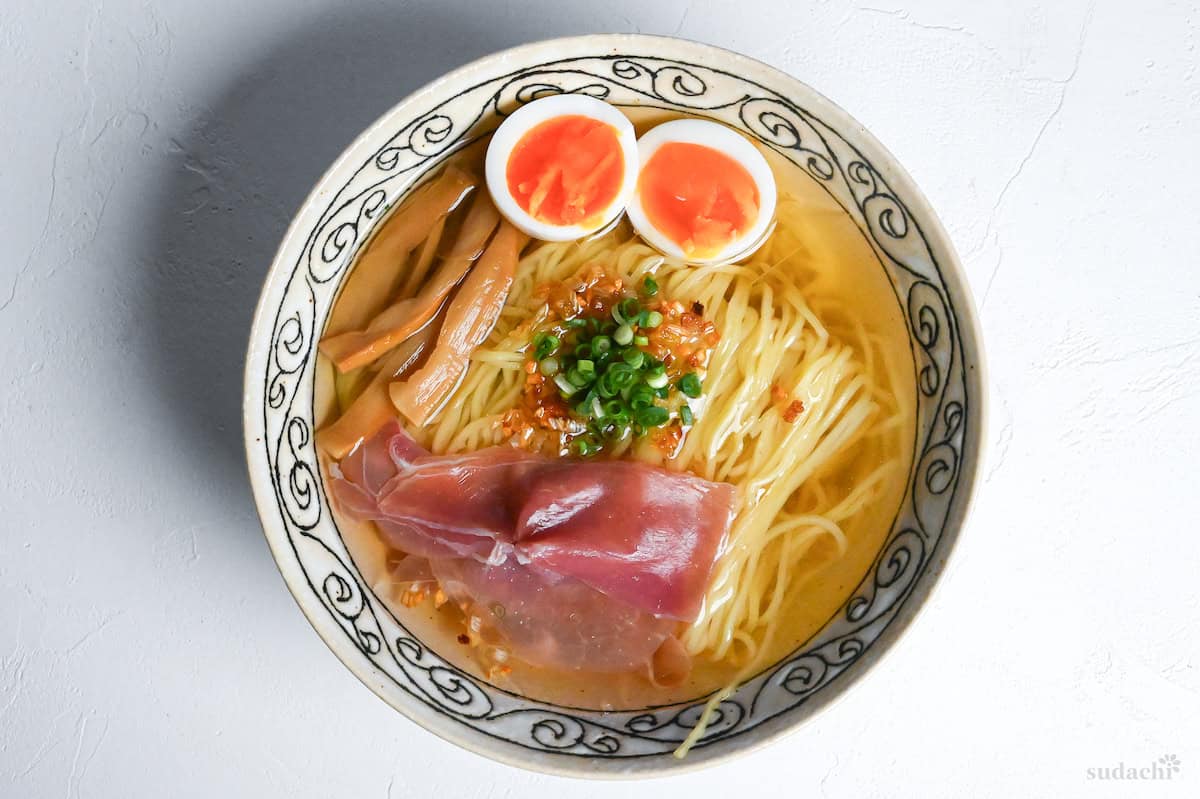
For my bowl, I only used soft boiled eggs, menma, dry cured ham, and chopped green onions.

Essential Tips & Tricks
- Use soft or filtered water when soaking kombu. Hard water blocks umami extraction and can leave the broth flat.
- Remove kombu just before the broth simmers.
- Steep katsuobushi off the heat for only 2 minutes.
- Strain through paper towel or fine cloth without pressing.
- Always check the broth volume before seasoning.
- Pre-mix tare with hot broth when serving multiple people to avoid uneven saltiness.
- Serve immediately after assembling.
With these simple tips in mind, you’re set for success every time you make shio ramen.
Storage & Meal Prep
Fridge: Clear chicken-kombu broth can be cooled quickly and stored in an airtight container in the fridge for 3-4 days. Homemade aroma oil solidifies when chilled but stays good for about 1 week.
Freezer: Broth freezes well in portioned freezer bags for up to 1 month.
Meal Prep: This recipe is highly meal-prep friendly if you split the elements. Make a large batch of broth on the weekend, freeze in single portions, and keep tare refrigerated in a sealed glass jar. With prepped soup, tare, and toppings, a weekday bowl takes only noodle-boiling and quick reheating.
Reheating: Always reheat components separately, then assemble. Warm broth in a saucepan over gentle heat until steaming but not boiling.
What to Serve With This Recipe
Shio Ramen Q&A
Cloudiness usually comes from boiling too hard or not skimming enough. Vigorous boiling emulsifies fat and protein into tiny particles. Keep the pot at a bare simmer and skim diligently in the first 10 minutes.
Always season with tare, not loose salt. Keep the base broth unsalted and add concentrated tare to adjust per bowl. This allows fine-tuning. If the broth is already too salty, dilute with unsalted dashi or hot water.
Shio simply means “salt.” In ramen, it refers to the salt-based tare (seasoning sauce) used to flavor the broth.
Despite the name, shio ramen isn’t overpoweringly salty. The salt enhances umami rather than overwhelming it. In fact, tonkotsu and miso ramen can feel saltier because of their heavier, richer bases.
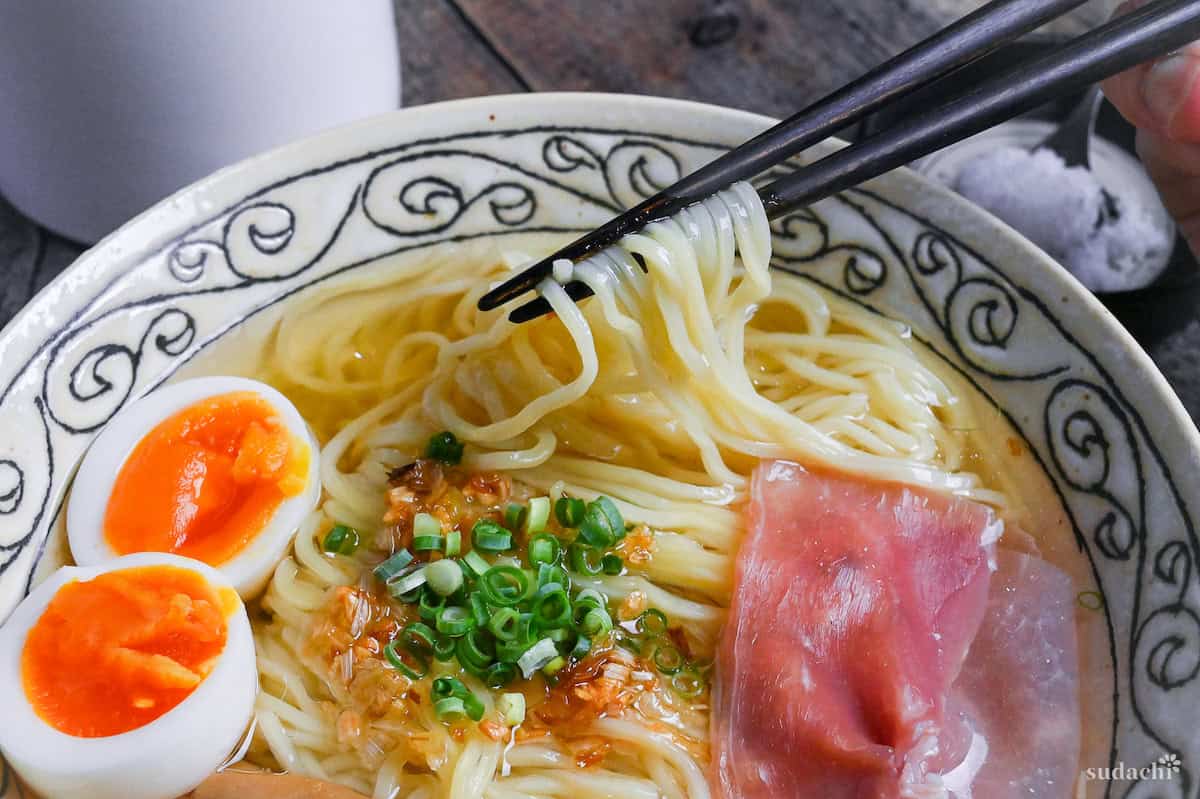
More Authentic Ramen Recipes
Want to bring the true taste of Japan to your kitchen? Dive into my authentic ramen recipes!
Did You Try This Recipe?
I would love to hear your thoughts!
💬 Leave a review and ⭐️ rating in the comments below. 📷 I also love to see your photos – submit them here!
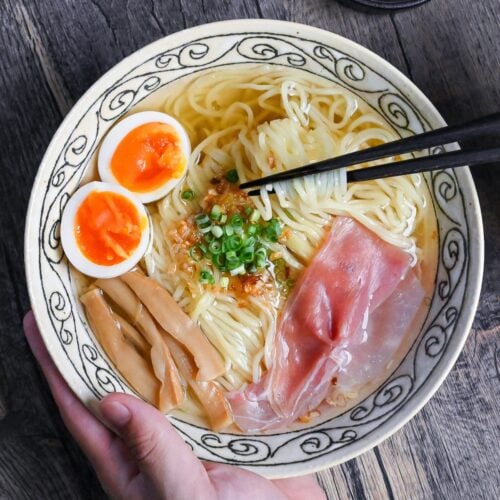
Shio Ramen From Scratch
Ingredients
Broth
- 2000 ml water preferably soft or filtered
- 10 g dried kelp (kombu)
- 15 g dried scallops (conpoy) or packing liquid from canned clams/scallops or clam juice
- 50 g Japanese leek (naganegi) green part cut in half/quarters, or regular leek/onion/shallot green
- 20 g ginger root
- 2 cloves garlic
- 200 g ground chicken or ground turkey or chicken wings/drumsticks
- 15 g bonito flakes (katsuobushi)
Flavored oil
- 3 tbsp lard or duck fat or chicken schmaltz
- 3 tbsp Japanese leek (naganegi) white part, finely diced, or substitute leek/onion
- 2 cloves garlic finely diced
Tare
- 4 tbsp sake or all white wine if unavailable
- 2 tbsp white wine dry
- 1 tbsp mirin
- 2 tsp salt high quality sea salt or blend sea salt and rock salt
- 1 tsp Japanese light soy sauce (usukuchi shoyu) or white soy sauce (shiro shoyu) or regular dark soy sauce in a pinch
Noodles and Toppings
- 4 portions ramen noodles thin or medium-thin, lower hydration preferred
- finely chopped green onions
- soft-boiled eggs or ramen eggs
- seasoned bamboo shoots (menma)
- yuzu zest or lemon zest
- deli meat of choice pastrami, turkey breast, proscuitto cotto or chicken cold cuts etc.
My recommended brands of ingredients and seasonings can be found in my Japanese pantry guide.
Can’t find certain Japanese ingredients? See my substitution guide here.
Instructions
Broth (30 mins)
- Measure 2000 ml water into a pot and add 10 g dried kelp (kombu) and 15 g dried scallops (conpoy). Soak for 30 minutes. While you wait, cut 50 g Japanese leek (naganegi) into rough pieces that will fit in your pot, wash and thickly slice 20 g ginger root, and peel and press 2 cloves garlic with the flat side of your knife so they crack a little.

- After 30 minutes, place the pot on the stove over medium heat. Add 200 g ground chicken and bring to a gentle simmer. When bubbles start to appear 82-90℃ (180-194°F), remove the kombu and scallops.

- Add the Japanese leek, ginger and garlic from earlier. Reduce the heat and gently simmer on low for 30 minutes uncovered. Skim the foam occasionally to keep the broth clear and avoid stirring. While you wait, prepare the flavored oil and tare.

Flavored Oil & Tare
- Grab a small pan and add 3 tbsp lard, 3 tbsp Japanese leek (naganegi) and 2 cloves garlic . Heat on low and keep a close eye on it, while you wait you can make the tare. Remove the pan from the heat as soon as the leek and garlic turns golden. Avoid browning as this can make the oil bitter.

- In a separate small sauce pan, add 4 tbsp sake, 2 tbsp white wine, 1 tbsp mirin and 2 tsp salt. Heat on medium, mixing until the salt has dissolved into the mixture. Boil gently for 2 minutes, then turn off the heat and stir in 1 tsp Japanese light soy sauce (usukuchi shoyu). Set aside for later.

Broth (Straining)
- After 30 minutes of simmering, use a mesh spoon to scoop out the ground chicken and aromatics. Turn off the heat, add 15 g bonito flakes (katsuobushi) and steep for 2 minutes.

- Place a fine-mesh strainer over a heatproof bowl and line with two layers of kitchen paper (or cheesecloth/coffee filters). Strain the broth without pressing or squeezing.

- Measure how much liquid is left, and top up with hot water so that each portion will have 350ml of broth (1.5 US cups). For 4 portions, you will want to top it up to 1400ml (6 US cups).

Noodles & Assembly
- Boil 4 portions ramen noodles according to the package instructions. Aim for al-dente.

- Divide the tare, broth and cooked noodles evenly between serving bowls, then drizzle the infused oil and golden aromatics on top.

- Top with finely chopped green onions, soft-boiled eggs, seasoned bamboo shoots (menma), yuzu zest and deli meat of choice. Serve up and enjoy!







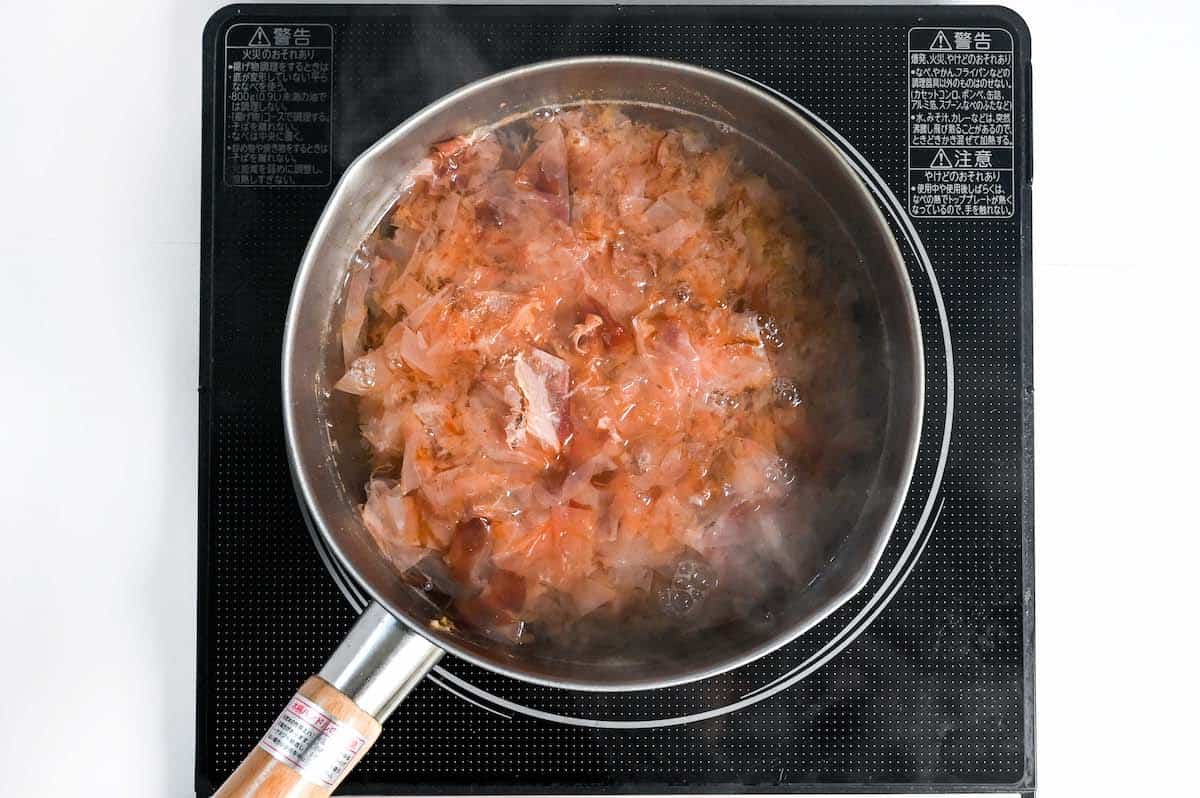
Today I wasn’t making the whole shio ramen w egg & chicken but only tried out the salad chicken recipe. I needed it for something else and for me this is the crucial element in this dish. Since I’m out of the 7/11 paradise with ready made salad chickens, I have been trying to recreate the same juiciness quality. I have to say – this recipe is a game changer and keeper. Fast, easy, dead reliable. Perfect outcome. Thank you Yuto-san.
Hi Isa,
Thank you so much once again for your wonderful feedback and photos! I’m so happy that this recipe helped satisfy your craving for salad chicken! 🙂 It’s great to hear that you found it reliable and easy to make!
Yuto